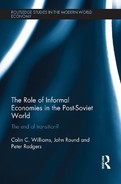Figures
4.1 A typology of work practices: the total social organisation of labour
5.1 Prevalence of envelope wages in East-Central Europe
5.2 Relationship between implicit tax rates on labour and envelope wages
5.3 Relationship between labour market policy spending and envelope wages
5.4 Relationship between social protection benefits and envelope wages
5.5 Relationship between impacts of state redistribution and envelope wages
6.1 Informal employment as a percentage of GDP, 2007: by country
6.2 Informal employment as a percentage of GDP, 2003–2012
6.3 Typology of the multifarious nature of informal employment
10.1 Configuration of labour practices in post-Soviet spaces: by gross formal income of household
10.2 Representations of informal economic activities in post-Soviet societies
Tables
3.1 Labour force participation rate (15–64 years old), 1990–2010 in post-Soviet/socialist societies
3.2 The paid/unpaid work balance in post-socialist economies
3.3 Primary sphere relied on by households to secure their livelihood in CIS countries, 2001
3.5 Share of households not receiving income from the formal economy, by country
4.1 Socio-economic profile of respondents to Ukraine survey of livelihood practices, 2005–2006
4.2 Participation rates in labour practices in Ukraine: by locality and gross household income
4.4 Socio-demographic profile of participants in Moscow survey: by locality type
4.5 Participation rates in labour practices in Moscow: by locality and gross household income
5.1 Labour force participation rate (15–64 years old), 2010 in post-Soviet/socialist societies
5.2 Characteristics of envelope wage arrangements in East-Central Europe
5.3 Attitude towards envelope wages in East-Central Europe: by population group
6.1 Prevalence and configuration of the undeclared economy in East-Central European countries
6.2 Consumers’ motives for using informal labour in Ukraine: by population group
6.4 Relationship between type of informal employment and reasons for participation in Ukraine
6.5 Share of self-employed working wholly or partially informally in Ukraine
6.7 Consumers’ motives for using informal employment in Moscow: by income level and location
6.9 Relationship between type of informal employment and reasons for participation in Moscow
8.1 Reasons for engaging in voluntary work in the Russian Federation
8.2 Participation rates in formal unpaid labour in Ukraine: by locality and gross household income
8.4 Participation rates in formal unpaid labour in Moscow: by locality and gross household income
9.1 Percentage of everyday tasks undertaken using self-provisioning in Ukraine, by task
9.2 Percentage of everyday tasks undertaken as self-provisioning in Ukraine, by income category
9.3 Typology of motives for self-provisioning
9.4 Primary reason for conducting self-provisioning in Ukraine: by household income
9.6 Reasons for conducting subsistence work in Moscow: by household income
